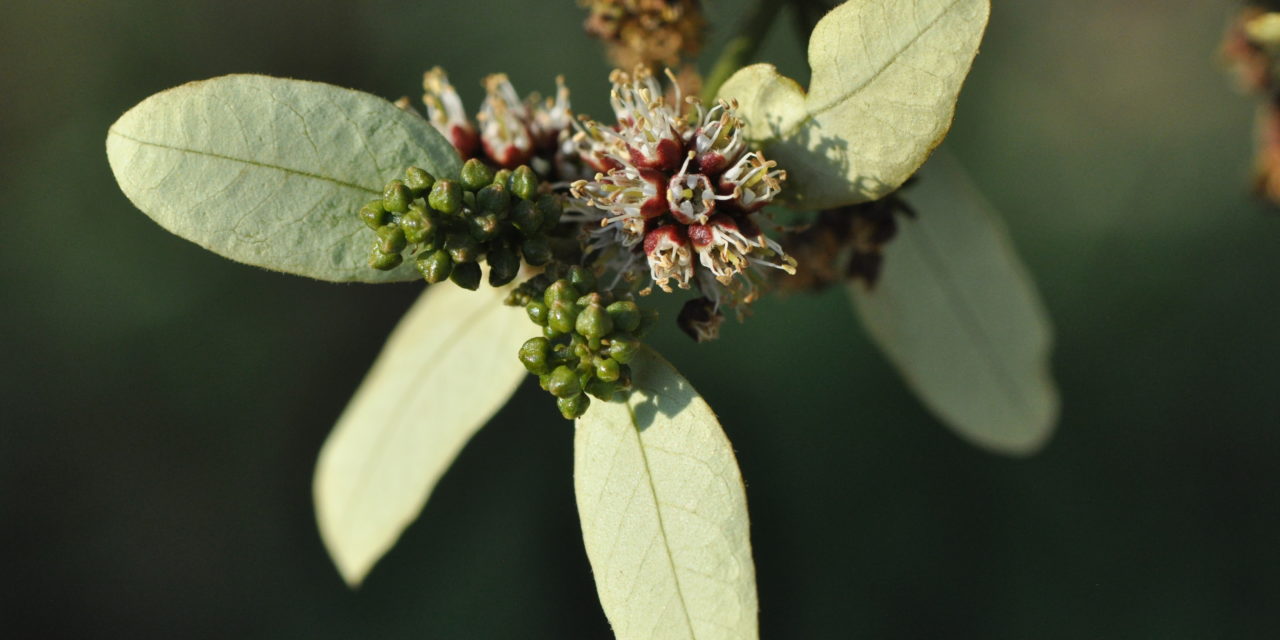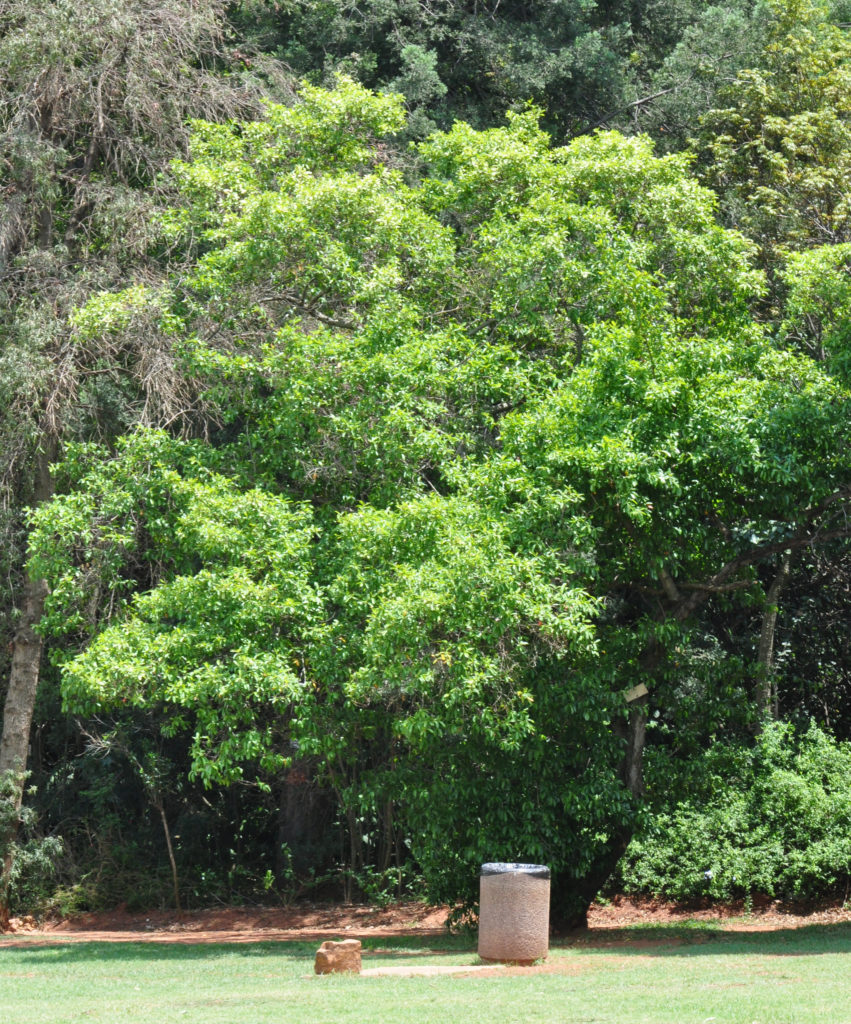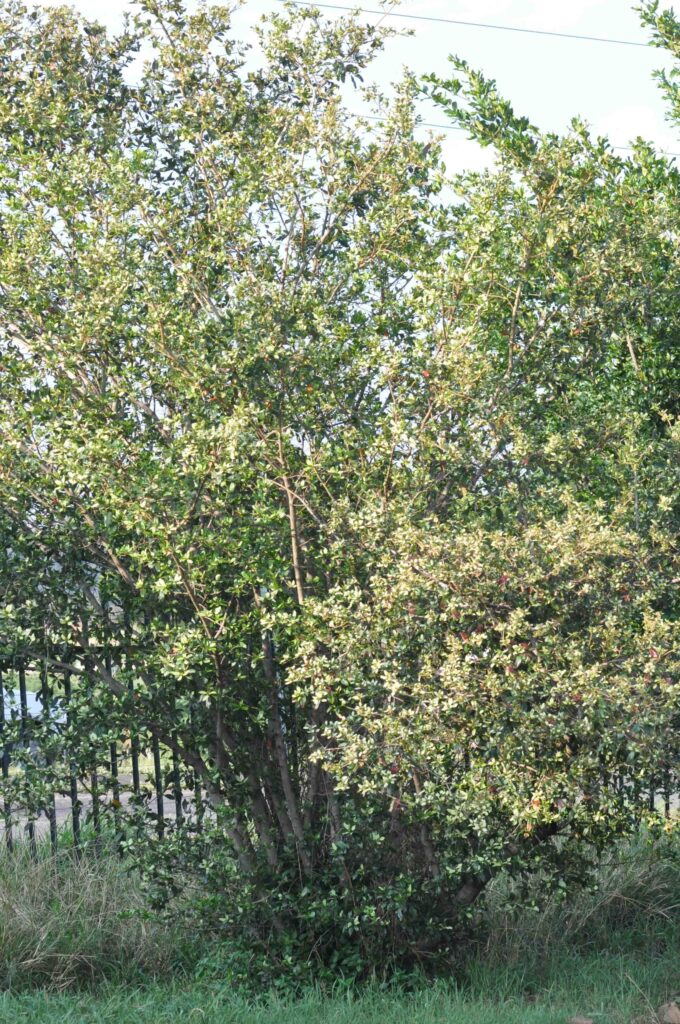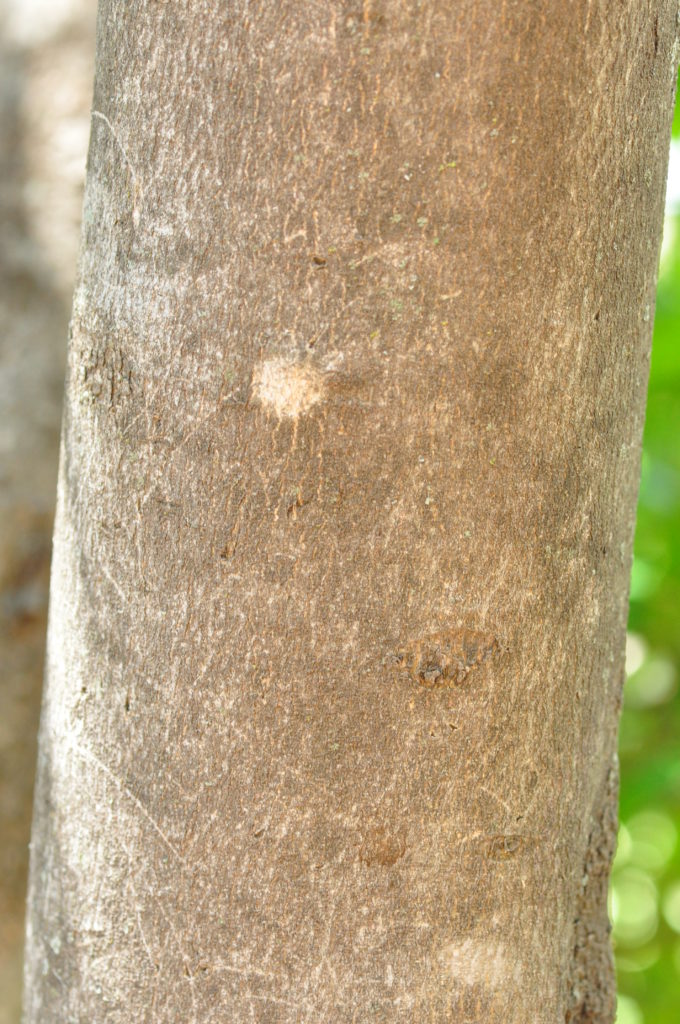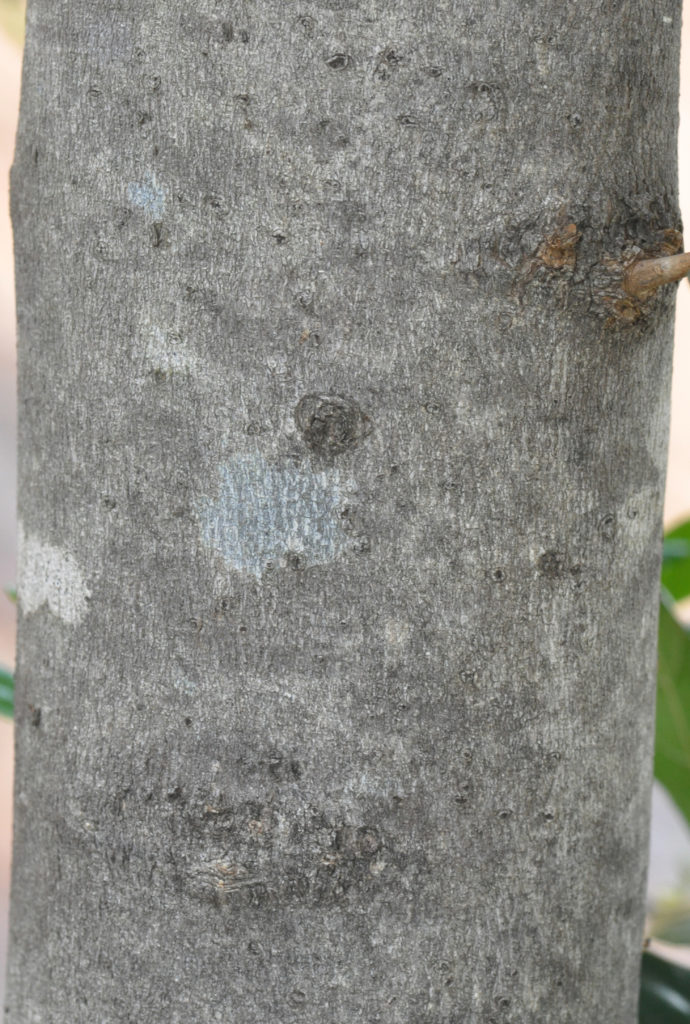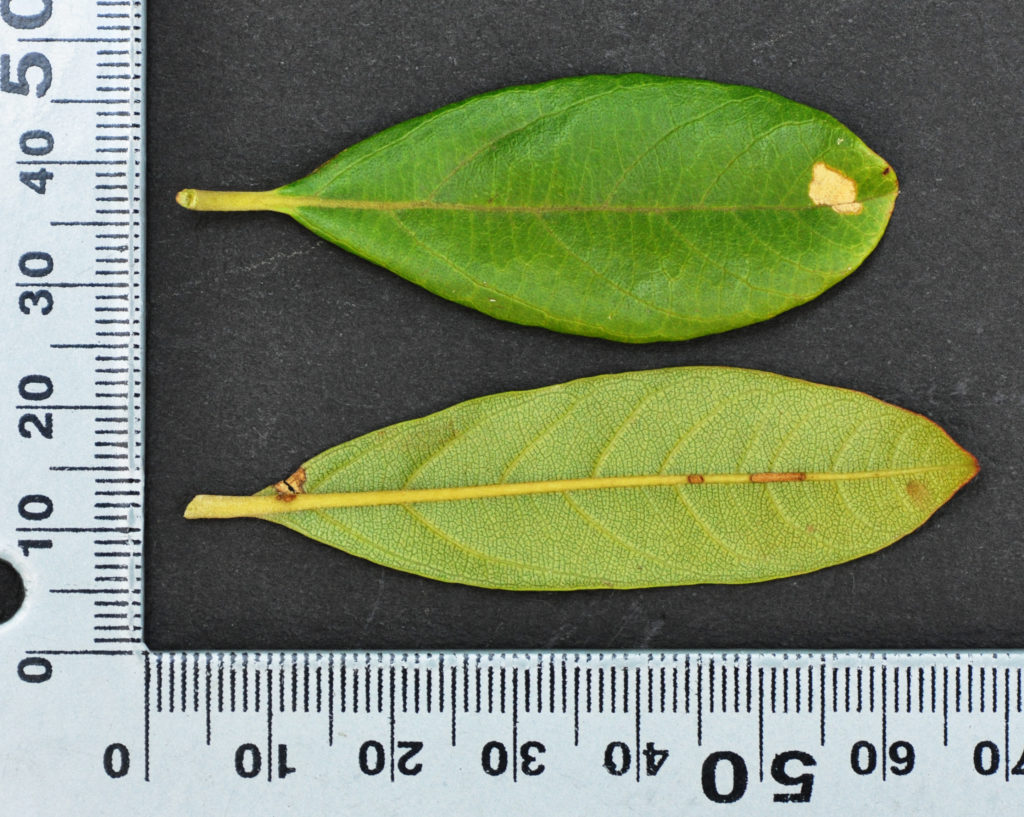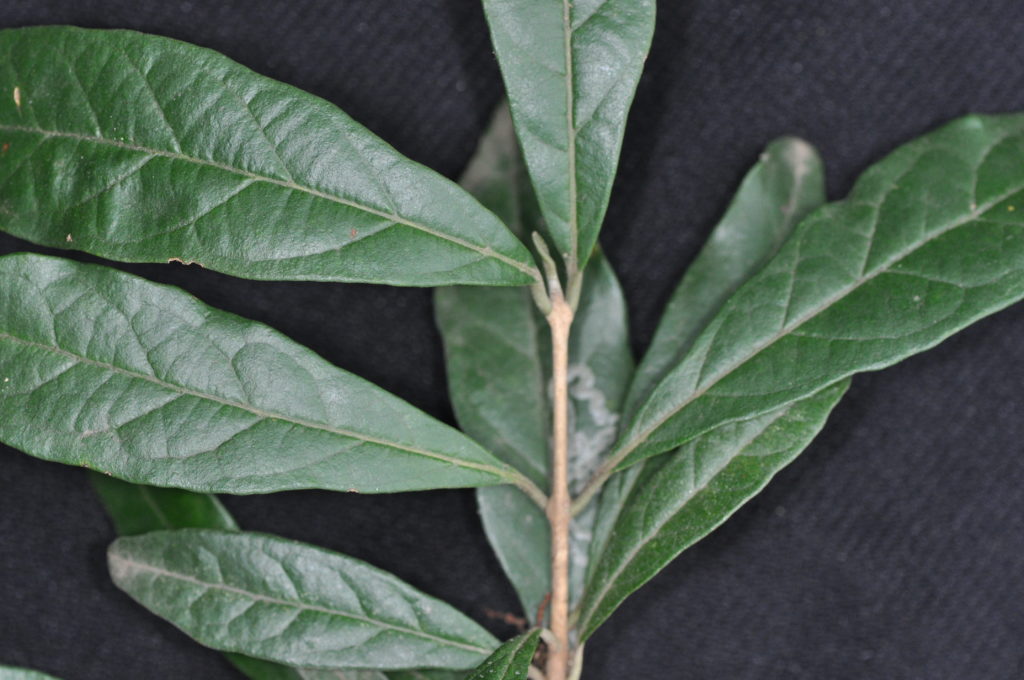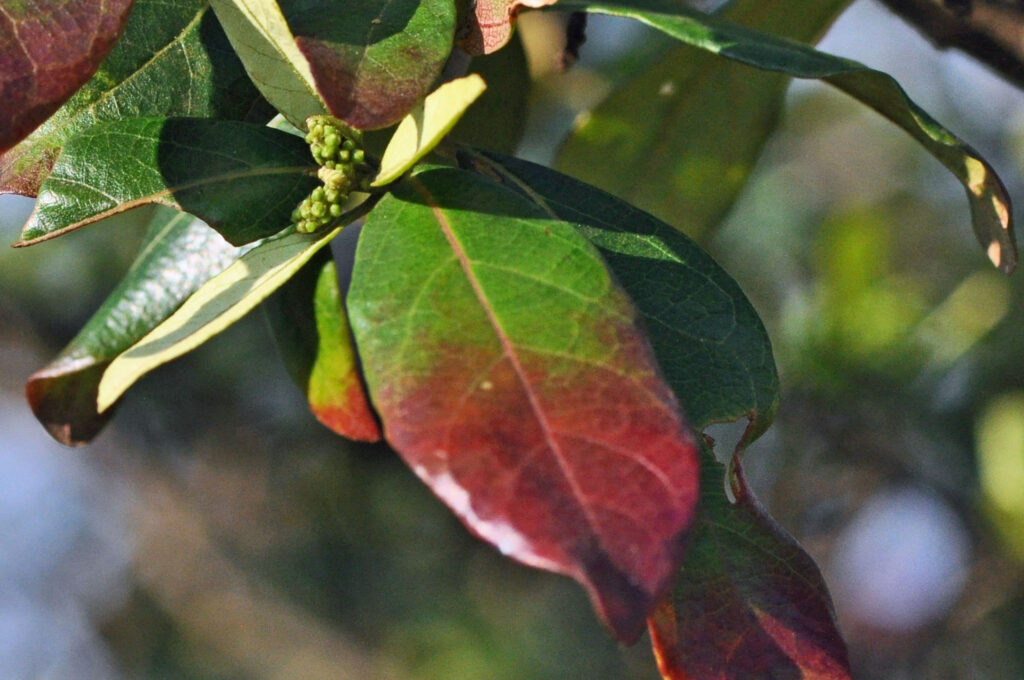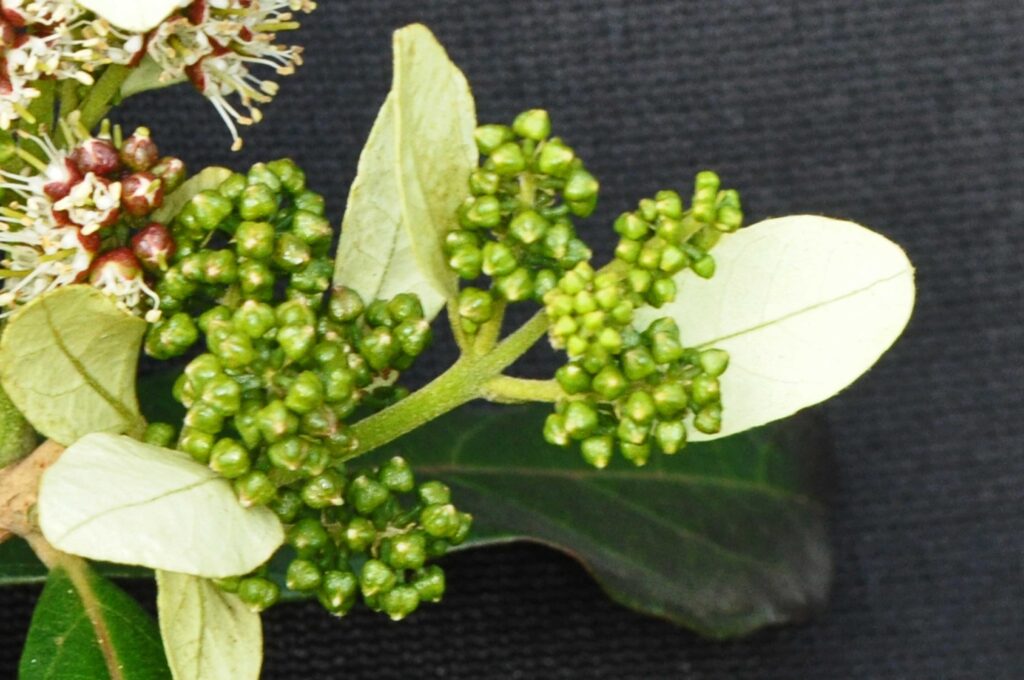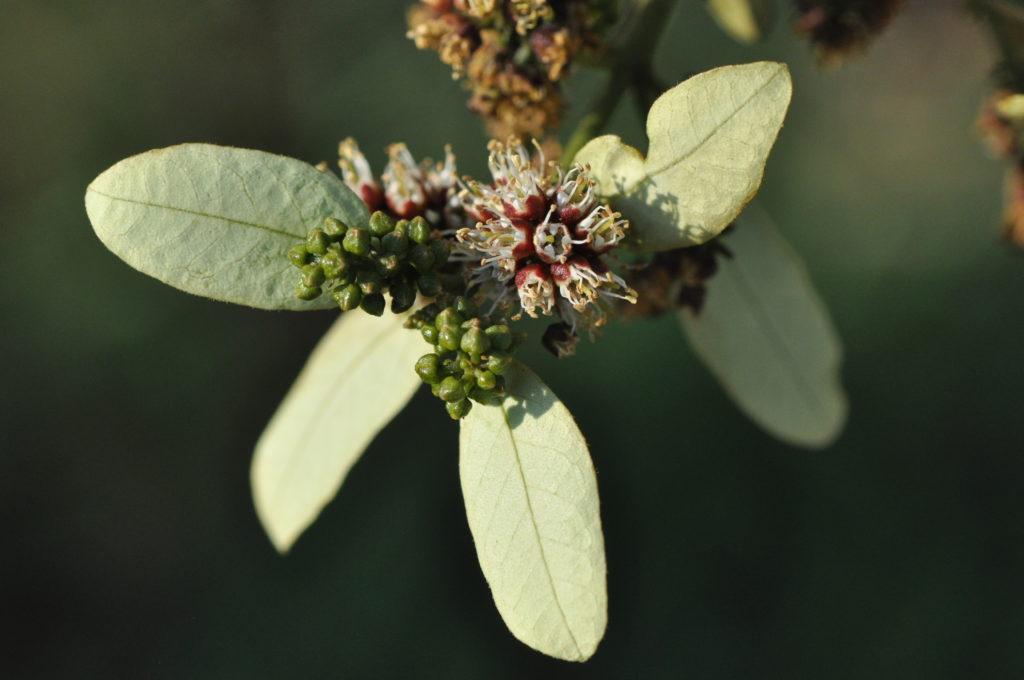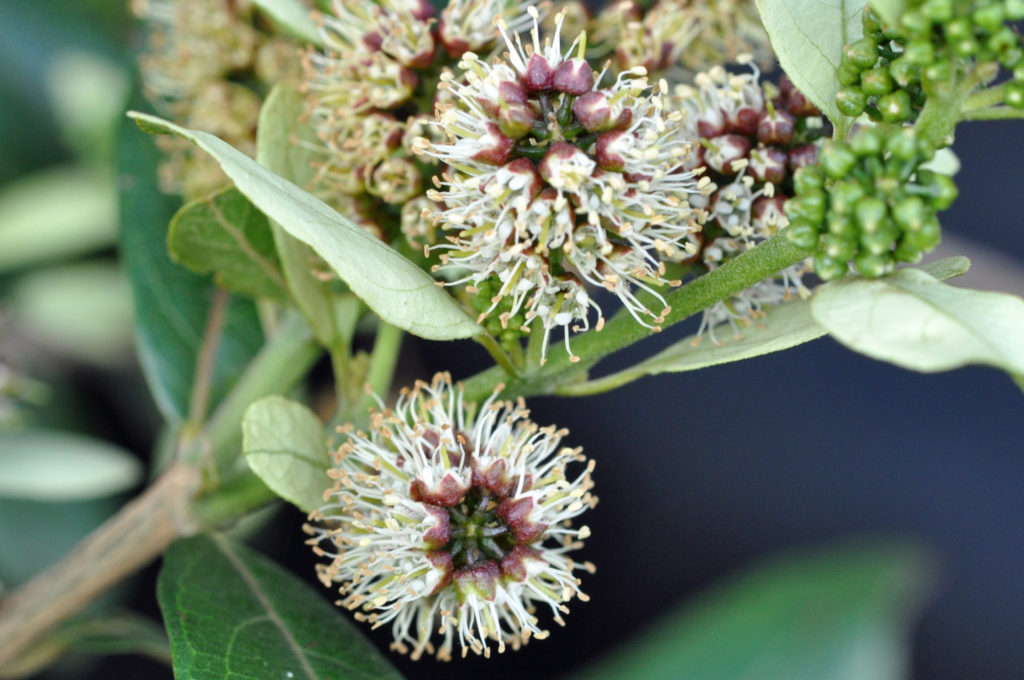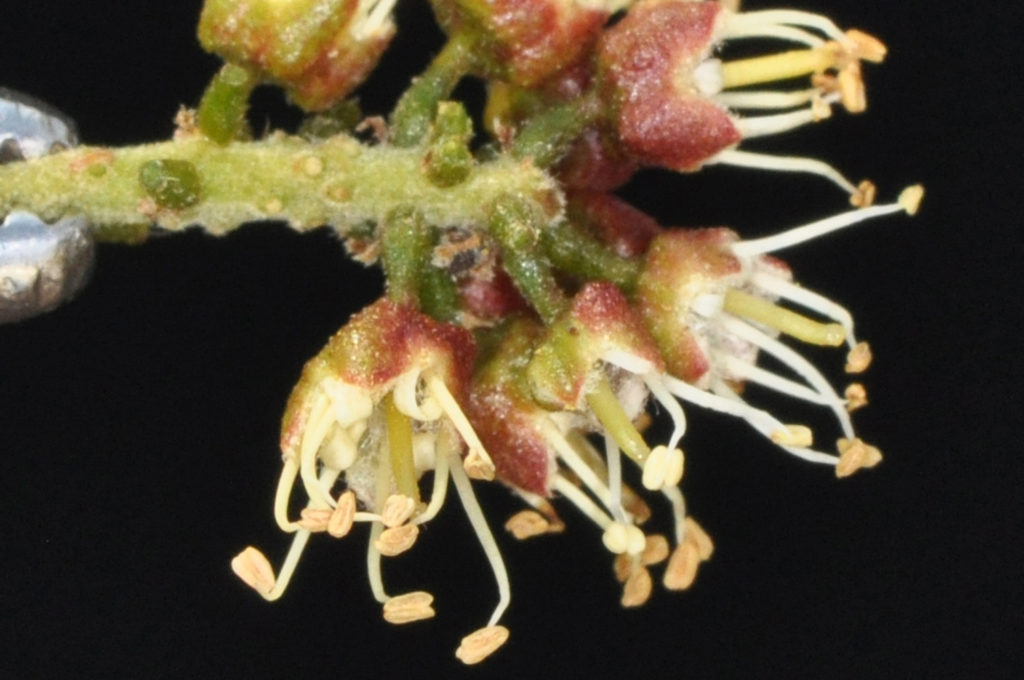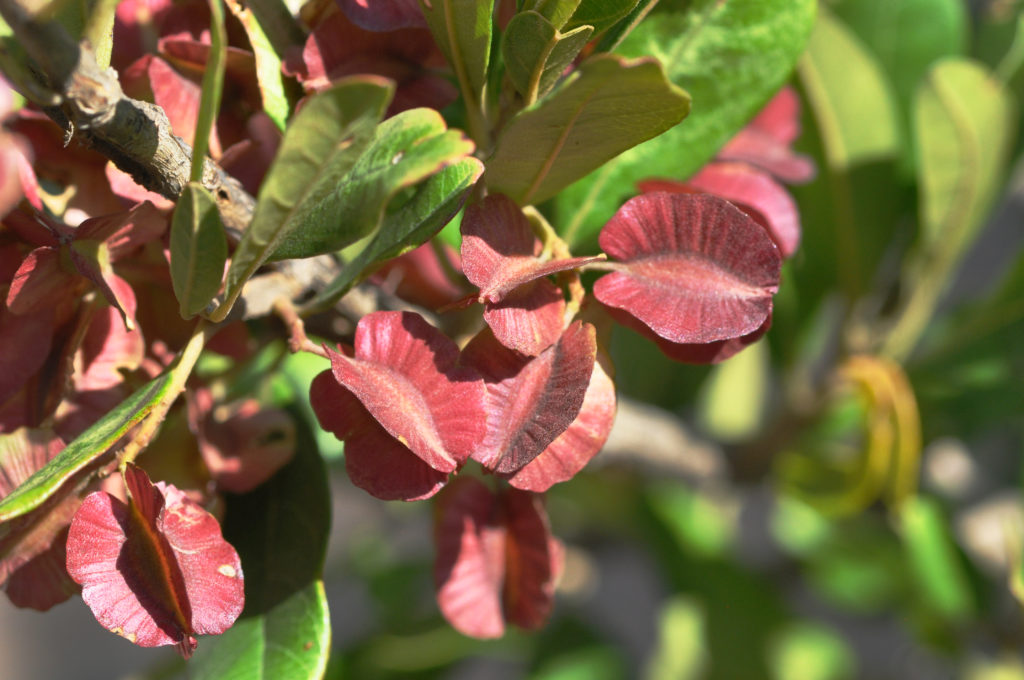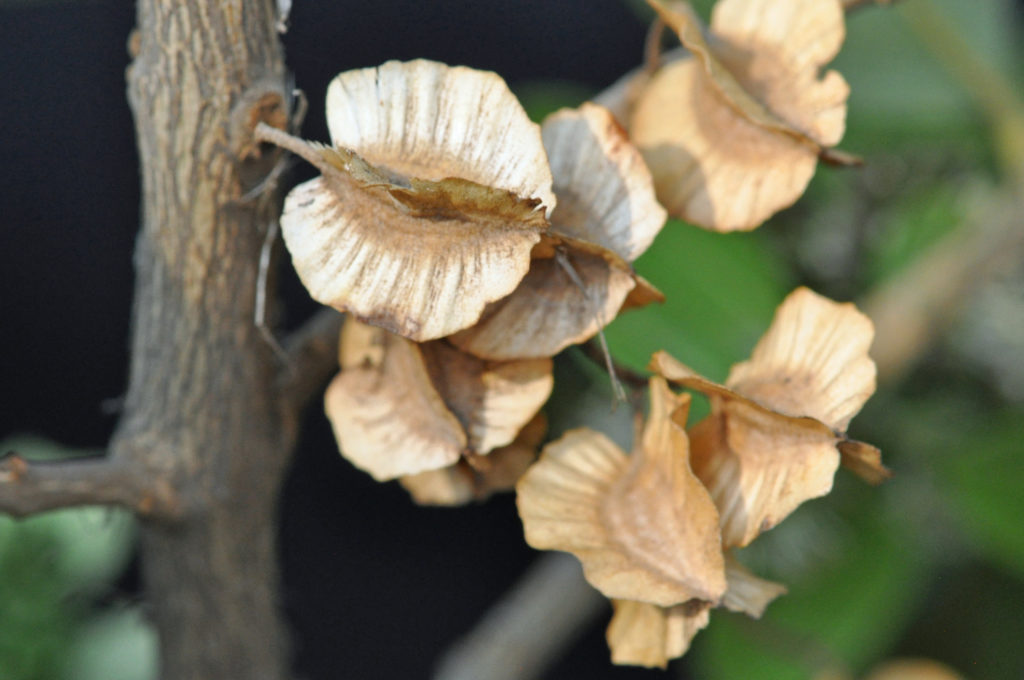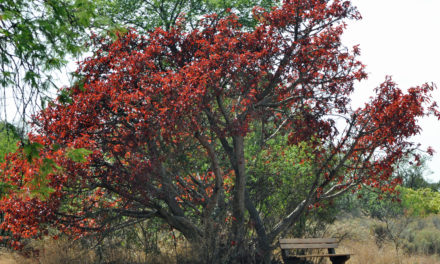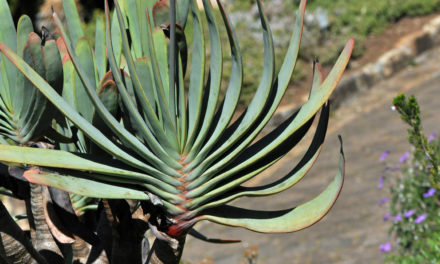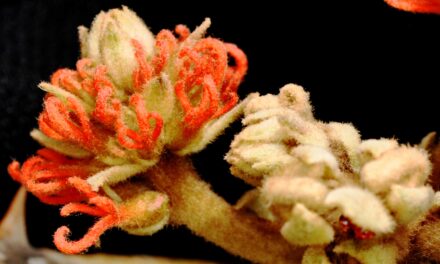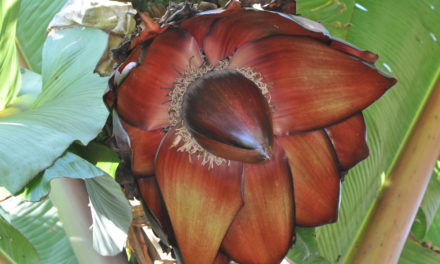General Info – summary
This shrub or Tree to 25m high has smooth grey bark that becomes brown. Opposite, simple Leaves are up to 12 x 5cm & elliptic to obovate. Leaves under flowers are white. Small, 4-merous, regular, bisexual and creamy white Flowers are in spikes. Sepals become reddish and the short petals are creamy white. 8 stamens surround the inferior ovary. The 4-winged, wind dispersed Fruit contains one wrinkled seed.
Description
Combretum kraussii
SA Tree No. 540.
Common names: (Afr) Bosvaderlandswilg, Bosvaderlandswilgerboom, Boswilg, Boswilgerboom, Vaderlandswilg, Rooiblaar, Rooiblad. (Eng) Forest Bushwillow, Forest Combretum. (Northern Sotho) Modlubu, Modubu. (isiXhosa) Ulandile, Umdubu-wehlathi. (isiZulu) Uhwabhu, Umdubu, Umdubu-wehlathi. (siSwati) Imbondvo-lemhlophe, Umdvu. (Tshivenda) Muvuvhu, Muvuvhu-wannda, Muvuvhu-wa-thavhani, Muvuvhu-thavha.
Family: Combretaceae (Bushwlillow family). In this family, there are about 16 genera, containing about 530 species. In South Africa, there are 5 genera and 41 species. Here the genera with Trees include Combretum, Lumnitzera, Pteleopsis and Terminalia. The simple and usually entire Leaves lack stipules. Flowers are usually bisexual, usually with twice the number of stamens as sepals or petals. The inferior Ovary has 1 locule and usually only 1 of the ovules develops into a seed. Fruit is usually indehiscent and can be winged or ridged.
Name derivation: Combretum – a climbing plant. kraussii in honour of Dr. F. Krauss (1812-1890) the director of the Natural History Museum in Stuttgart. He visited the Cape from 1837 to 1840 and collected over 2 300 plant specimens.
Conservation: National Status: L C. (Least Concern). Assessors: 2005 (W. Foden and L. Potter).
Tree
This unarmed medium to tall Tree may reach 25m in the forest canopy where it is often single stemmed (photo 436). The trunk is up to 0,8m wide. In open areas, it may be a multi-stemmed shrub (photo 250). The Bark (photos 252 & 435) is pale grey to brown and smooth, becoming dark grey, furrowed and even flaking in older specimens. Young smooth Branches are greenish to greyish (photo 657 under Leaves).
- 436 2016/11/08 Pretoria NBG. Photo: David Becking.
- 250 2016/11/08 Pretoria NBG. Photo: David Becking.
- 435 2016/11/08 Pretoria NBG. Photo: David Becking.
- 252 2016/11/08 Pretoria NBG. Photo: David Becking.
Leaves
In this densely leafy, deciduous or semi-deciduous tree, the thinly leathery, opposite (photo 657), or nearly so Leaves are simple (have a single blade which may have incisions that are not deep enough to divide the leaf into leaflets). They are (12) 7 x 2 (5) cm and form on short lateral twigs. Leaves are elliptic to obovate (upside-down egg-shaped, and usually widest just beyond the middle – photo 369). The tree is occasionally deciduous (loss of leaves for part of the year – induced by either temperature drop, or a shortage of water. The process is abscission). Leaf loss is usually small. Young terminal spring leaves are whitish (photo 269 – under Flowers). Older leaves are glossy dark green above (photo 657) and lighter below (photo 369). The Midrib and four to 12 pairs of raised lateral Veins are visible on the under surface. Here many other veins may be visible. On the upper surface, the lateral veins curve and join – without reaching the margin (photo 657). The visibility of the smaller veins on the lower surface is partly due to lack of hairs (photo 369). The leaves, or part thereof, turn an impressive vivid red to purple before falling (photo 256). Hair-tuft Domatia (a tiny chamber produced by plants that house arthropods. To the naked eye the domatia appear as small bumps) may be visible in vein axils on the under surface. Small scales, appearing as dots, may also be seen on the under surface. The Apex is tapering to rounded (photo 369) or has a pointed tip, which may be sharp. The Base tapers gradually from near the centre. The Margin is wavy, rolled under and entire (with a continuous margin, not in any way indented). The Petiole (leaf stalk) is usually short: 2-8mm long. Leaves are wider than those of Combretum erythrophyllum.
- 369 2015/02/24 Walter Sisulu Nursery. Photo: David Becking. alter Sisulu
- 657 2017/01/31 Pretoria NBG. Photo: David Becking.
- 256 2016/11/08 Pretoria NBG. Photo: David Becking.
Flowers
The small creamy white, bisexual Flowers are in dense elongated or oblong Spikes (simple indeterminate inflorescences with sessile flowers on a single unbranched stalk – buds in photo 248). Each spike is up to 8cm+ long. Flowers are actinomorphic (Regular, symmetrical. Flowers are vertically divisible into similar halves by more than 1 plane passing through the axis) and Bracts (modified specialised leaves usually found with inflorescences and flowers) are present. Flowers appear above the new white leaves (Aug-Jan: photo 269). The white colour acts as a beacon to Pollinators. This distinct colour difference attracts insects to the flowers (photo 248 & 269 under Flowers). These white flowers fall and are replaced by fresh green leaves.
Each 4-merous flower has 4 red Sepals in the Calyx forming an extension above the ovary (photo 261). 4 very short, triangular and creamy white Petals are present. The 8 Stamens are in 2 whorls. The initially white Filament of each stamen is attached to the centre of the Anther i.e., dorsifixed (photo 261). The single Pistil has an inferior Ovary (one which is seemingly below the calyx). This inferior ovary can be mistaken (dark green in photo 261) for an absent Pedicel (stalk of a single flower). The yellow thickened and free Styles are visible in photo 261. The flowers are insect pollinated. (Aug-Nov).
- 248 2016/11/08 Pretoria NBG. Photo: David Becking.
- 269 2106/11/08 Pretoria NBG. Photo: David Becking.
- 247 2016/11/08 Pretoria NBG. Photo: David Becking.
- 261 2016/11/08 Pretoria NBG. Photo: David Becking. Partially dissected.
Fruit
The 4-winged Fruit is dry, indehiscent and rests on a short, mature Pedicel (stalk of a single flower). The Wings are papery and aid the wind-dispersal of the seeds. The fruits are up to 2 x 2cm or slightly longer and often located in clusters. Notches are present at both ends of the fruit. The ripening fruit is greenish, becomes yellowish, even purplish with dark deep impressive pink or reddish wings (photo 366), and turns brownish with age (photo 249). Eventually a single wrinkled Seed develops. (Nov-Jun).
- 366 2015/02/24 Walter Sisulu Nursery. Photo: David Becking.
- 249 2016/11/08 Pretoria NBG. Photo: David Becking.
Distribution & Ecology
These Plants are moderately frost and drought resistant and found in evergreen forests and forest margins – often on basaltic soils (basalt – quick cooling, low viscosity, usually fine grained, dark grey to black rock formed by the solidification of magma i.e. molten rock). They occur from sea level to an altitude of about 1 200m in most environments from the midlands to the coast. This tree is a southern African Endemic (endemism is the ecological state of a species being unique to a defined geographic location). They are located in the Eastern region of southern Africa: Eastern Cape – often along the coast, KwaZulu-Natal, Limpopo, Mpumalanga, as well as southern Mozambique and Swaziland.
Ethnobotany
The Tree is fast growing – up to 1m per year. It is not poisonous, tolerates low frost, moderate drought, requires little maintenance and is a good garden tree. Roots are not invasive. Young trees need protection from frost for the first 2 years. Wood is bright yellow, dense and hard but is subject to borer attack. Young flexible Branches are used to make baskets. Sawdust can be very irritating to eyes and skin. Roots are used in local medicine.
Combretastatins are a class of natural phenols that have been extracted from the bark and may help in the reduction of tumours in man.
References
Boon, R. 2010. Pooley’s Trees of eastern South Africa. Flora and Fauna Publications Trust, Durban.
Burrows, J.E., Burrows, S.M., Lotter, M.C. & Schmidt, E. 2018. Trees and Shrubs Mozambique. Publishing Print Matters (Pty) Ltd. Noordhoek, Cape Town.
Coates Palgrave, M. 2002. Keith Coates Palgrave Trees of Southern Africa, edn 3. Struik, Cape Town.
Foden, W. & Potter, L. 2005. Combretum kraussii Hochst. National Assessment: Red List of South African Plants version 2020.1. Accessed on 2023/01/05.
Palmer, E. & Pitman, N. 1972. Trees of southern Africa. Balkema, Amsterdam, Cape Town.
Schmidt, S. Lotter, M. & McCleland, W. 2002. Trees and Shrubs of Mpumalanga and the Kruger National Park. Jacana, Johannesburg.
van Wyk, B. & van Wyk, P. 1997 Field guide to Trees of Southern Africa. Struik, Cape Town.
Richard Boon and Andrew Hankey: thank for the help with ID.
http://www.plantzafrica.com/plantcd/combretkraus.htm
http://witkoppenwildflower.co.za/combretum-kraussii/
https://en.wikipedia.org/wiki/Combretastatin

